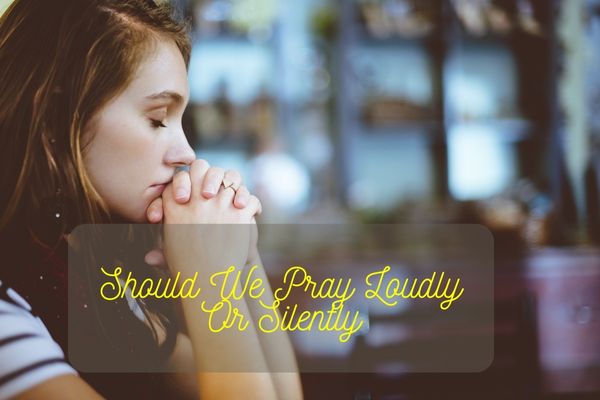Prayer, a timeless practice embedded in human culture, comes in various forms. One fundamental choice individuals grapple with is whether to pray loudly or silently. The debate transcends mere preference; it looks into the psychological, spiritual, and cultural dimensions of human experience. In this exploration, we’ll navigate the depths of silent and vocal prayer, unravelling their histories, benefits, and how they shape our well-being.
Should We Pray Loudly Or Silently
The method of communication with the divine is a deeply personal choice. The dichotomy between silent and vocal prayer has stirred contemplation for centuries. Understanding the power and nuances of each approach is essential for anyone seeking a more profound connection with their spirituality.
The Power of Silent Prayer
Historical roots of silent prayer
Silent prayer, deeply ingrained in diverse religious and spiritual legacies, transcends cultural and geographical boundaries. Eastern traditions, like Buddhism and Hinduism, emphasize contemplative silence as a means of connecting with the inner self and the divine. In Western Christianity, silent moments of reflection during worship or personal devotion have been integral to fostering a profound connection with God.
The historical wave of silent prayer is woven with threads of introspection, humility, and a quest for spiritual transcendence. Its universality lies in its ability to offer solace and communion with the sacred, regardless of the specific beliefs or rituals associated with each tradition. This shared aspect of silent prayer highlights its timeless significance, uniting individuals across the globe in a contemplative space that goes beyond religious divides, echoing the innate human desire for quiet communion with the divine.
Benefits of silent prayer
The hushed whispers of silent prayer carry profound benefits. Scientifically, the neurological effects of silent prayer contribute to a sense of inner peace and focus. Many practitioners attest to the transformative power of this quiet communion with the divine.
Vocal Prayer
Cultural and religious traditions of vocal prayer
In diverse cultures and religions worldwide, vocal prayer manifests as a celebration of joyous noise. From the rhythmic cadence of hymns and chants to the eloquent expression of spoken words, the act of vocalizing prayers holds a profound place in numerous faith traditions. This audible form of worship serves as a communal expression, fostering a sense of unity and shared devotion within religious congregations.
The uplifting melodies and articulated words become conduits for conveying faith, gratitude, and supplication. Whether it’s the melodic call to prayer in Islam, the soul-stirring hymns in Christianity, or the vibrant kirtans in Hinduism, vocal prayer acts as a dynamic and resonant medium for connecting individuals with the divine. Across the rich shade of human spirituality, the joyous noise of vocal prayer stands as a testament to the vibrant and expressive nature of religious worship.
The psychological impact of vocalizing prayers
The act of vocalizing one’s thoughts and desires is a powerful psychological phenomenon. Vocal prayer can serve as a cathartic release, offering individuals a tangible way to express their innermost thoughts and emotions.
Community aspects of loud prayer
In many cultural and religious settings, communal vocal prayer fosters a sense of unity. The shared experience of expressing beliefs aloud can create strong bonds within a community.
Finding Balance
Understanding individual preferences
Acknowledging the diversity of personal preferences in prayer is crucial. What resonates with one individual may not necessarily align with another’s spiritual journey.
Blending silent and vocal prayer
Rather than a binary choice, finding a balance between silent and vocal prayer can offer a more comprehensive spiritual experience. Recognizing the strengths of each method allows for a harmonious integration.
Contextual considerations
The context surrounding prayer significantly shapes the decision between silent and vocal expression. The adaptability of prayer practices to specific circumstances is crucial for fostering a more profound and authentic connection with the divine. In private moments of introspection or deep contemplation, individuals often turn to silent prayer, creating a space for personal reflection and a direct, internal dialogue with the sacred.
Conversely, in communal settings, such as religious congregations or ceremonies, vocal expression emerges as a shared celebration, fostering unity among believers. The choice between silent and vocal prayer becomes a dynamic and intentional decision, responding to the nuances of the moment. This adaptability not only reflects the diversity within religious practices but also underscores the essence of authenticity, allowing individuals to engage with their spirituality in a manner that resonates with the circumstances at hand, promoting a richer and more meaningful connection with the divine.
The Science Behind Prayer
Neurological effects of silent prayer
Scientific studies look into the neurological impact of silent prayer, revealing changes in brain activity associated with heightened states of focus and calmness.
Impact of vocal prayer on brain activity
Similarly, the act of vocalizing prayers has distinct effects on brain function. Understanding these neuroscientific aspects sheds light on the holistic benefits of prayer.
Scientific studies and findings
A survey of relevant scientific literature provides valuable insights into the intersection of spirituality and neuroscience. The amalgamation of ancient practices and modern research paints a fascinating picture of prayer’s impact on the human brain.
Addressing Common Misconceptions
Debunking myths about prayer methods
Misconceptions surrounding silent and vocal prayer can cloud the understanding of their respective merits. Dispelling these myths is crucial for individuals seeking a genuine and informed spiritual practice.
Cultural variations in prayer practices
Recognizing that prayer methods vary across cultures is essential for fostering respect and understanding. Embracing the richness of diverse practices enhances the global wave of spirituality.
Tips for Effective Prayer
Creating a conducive environment
Establishing a suitable environment for prayer, whether silent or vocal, is pivotal. Tips for crafting a space conducive to spiritual connection will be explored.
Maintaining focus and sincerity
The essence of prayer lies in sincerity. Practical suggestions for maintaining focus and sincerity in prayer help individuals derive deeper meaning from their spiritual endeavours.
Combining traditional and personal elements
Balancing tradition with personal touches in prayer rituals creates a unique and authentic experience. Exploring ways to infuse personal elements into established practices enhances the spiritual journey.
Cultural Perspectives on Prayer
Exploring how different cultures approach prayer
Diverse cultures worldwide approach prayer with unique perspectives. Examining these cultural variations sheds light on the universal and distinct aspects of the human quest for spiritual connection.
Shared values and diverse expressions
Despite cultural differences, shared values often underpin various expressions of prayer. Recognizing these common threads fosters a sense of unity amid the rich wave of global spiritual practices.
The Impact on Well-being
Mental and emotional benefits of prayer
Scientific studies support the claim that prayer positively impacts mental and emotional well-being. Exploring these benefits provides a holistic understanding of prayer’s potential to enhance overall health.
Role of prayer in stress reduction
In the fast-paced modern world, stress reduction is a universal concern. How prayer, whether silent or vocal, serves as a powerful tool for managing stress will be explored.
Integrating Prayer into Daily Life
Practical tips for incorporating prayer routines
Making prayer a seamless part of daily life requires practical tips. From morning rituals to bedtime routines, suggestions for seamlessly integrating prayer into daily life will be provided.
Recognizing the spiritual in the ordinary
Elevating the ordinary to the spiritual, we’ll explore how individuals can find moments of connection throughout their daily routines. Recognizing the sacred in the mundane enhances the depth of spiritual practice.
Respect for Diverse Practices
Embracing tolerance and understanding
Fostering a spirit of tolerance and understanding toward diverse prayer practices is essential in today’s interconnected world. Building bridges of respect strengthens the fabric of global unity.
Fostering unity amid diversity
Despite differing practices, the overarching goal of spiritual connection unites individuals across cultures. Nurturing unity amid diversity is a powerful message for a harmonious world.
Conclusion
In the wave of silent and vocal prayer, each thread contributes to the rich fabric of human spirituality. Whether one chooses to pray silently or with a resonant voice, the essence lies in the sincerity of the connection forged with the divine. As we navigate the diverse landscapes of prayer practices, may we find unity in our shared quest for spiritual fulfilment.
Frequently Asked Questions
1. How often should I pray?
The frequency of prayer is a personal choice, varying from daily rituals to spontaneous moments of connection. Find a rhythm that resonates with your spiritual journey.
2. Can I combine silent and vocal prayer?
Absolutely. Many individuals find a harmonious balance by blending silent and vocal prayer. Experiment to discover what feels most authentic and meaningful for you.
3. Are there scientifically proven benefits to prayer?
Yes, scientific studies suggest that prayer can positively impact mental and emotional well-being. It can contribute to stress reduction and foster a sense of inner peace.





